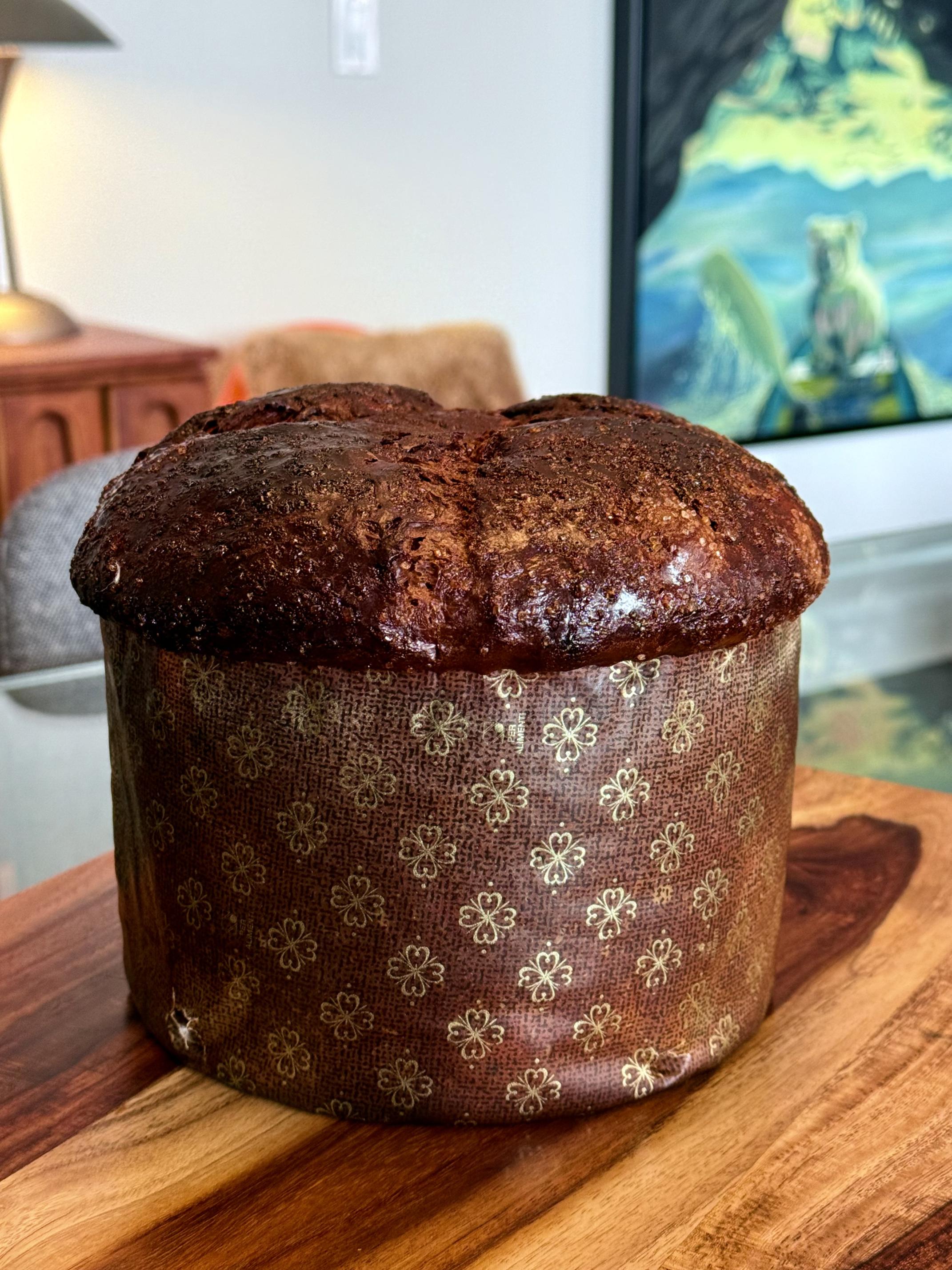
After getting my starter active again I wanted to have another go at Giorilli’s panettone recipe to see if my previous bake was a lucky fluke or if I could repeat its success. I’m pretty happy with the results of the bake, although I haven’t yet sliced into the panettone. I never actually measured the total weight of the dough the first time, when I did this time I noticed that the total weight was 1200 g. This is far greater than I expected as the recipe states that it is for 1 kg dough which is the amount for the molds that I have. I went through the ingredient measurements and 1200 g is approximately what they add up to. So for this bake I divided the dough into 950 g for the main panettone and then the 250 g of remaining dough I divided by six and placed each small boule into cupcake molds. I probably should have gone with eight since the dough almost filled 50% of the cupcake molds so the dough couldn’t ferment long enough. Despite that, the panettini turned out well and I can vouch for the combination of candied lemon and tart cherries that I decided to use for this bake. Once again I made the candied lemon peel for these panettini and panettone.
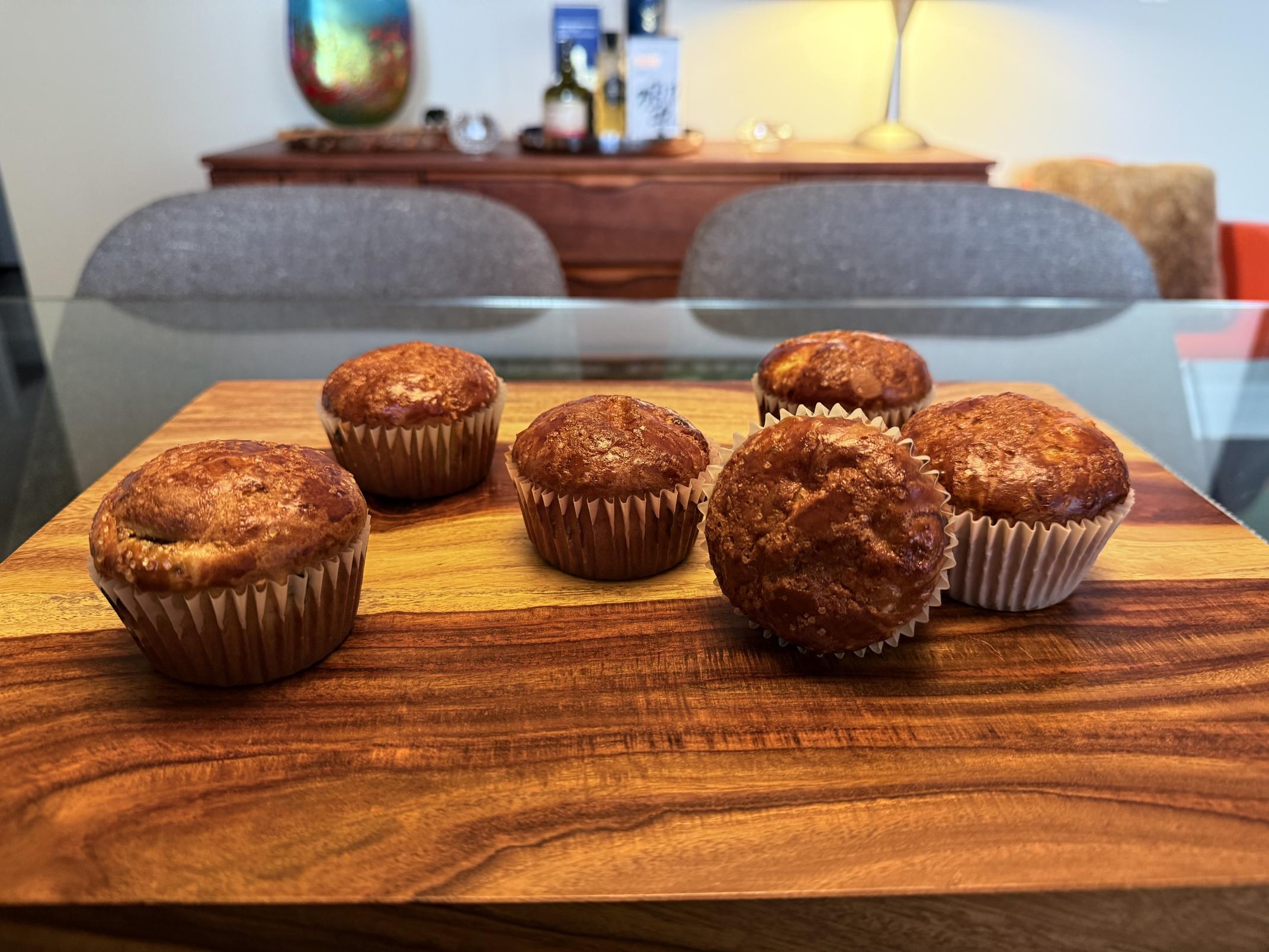
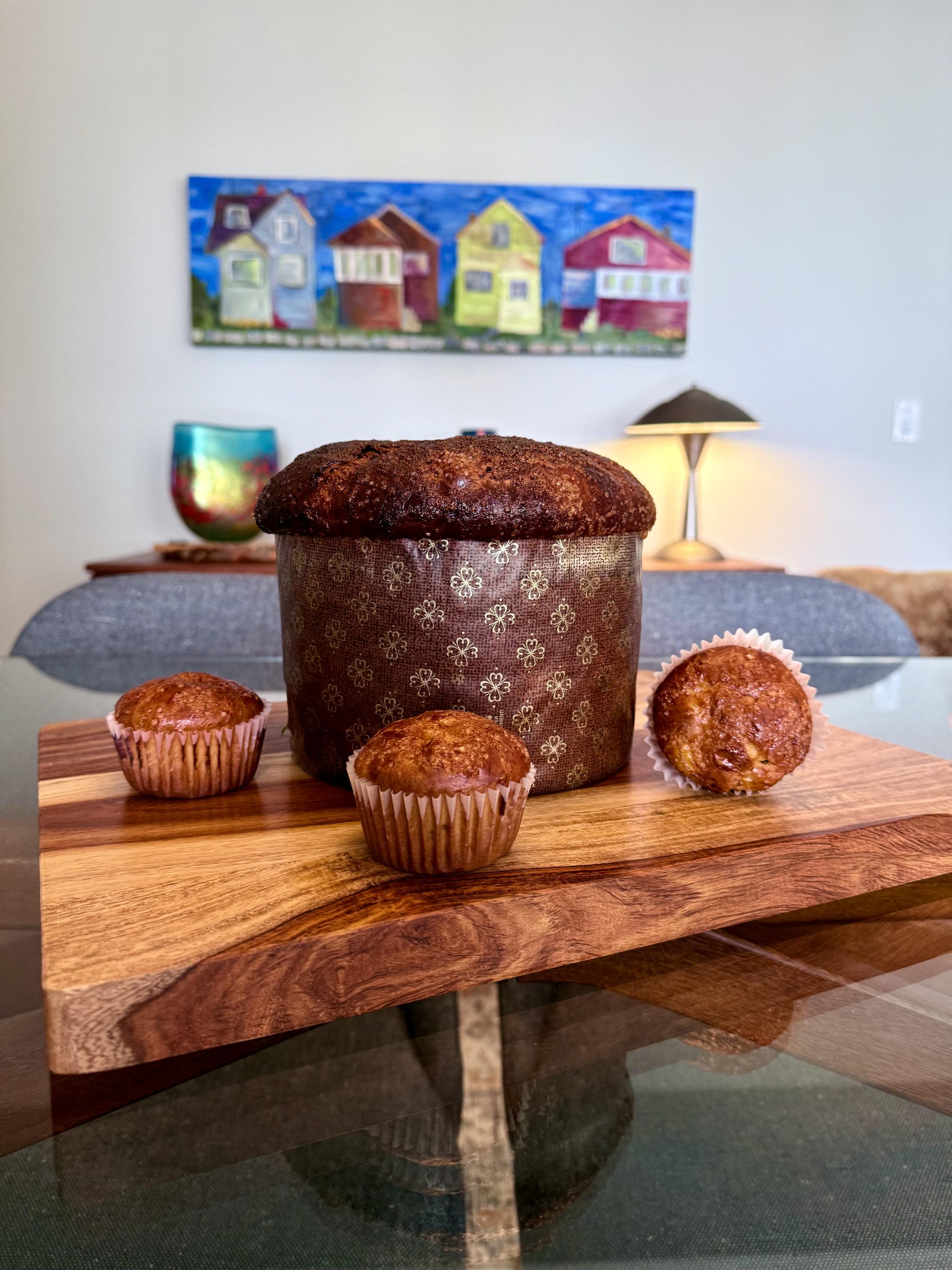
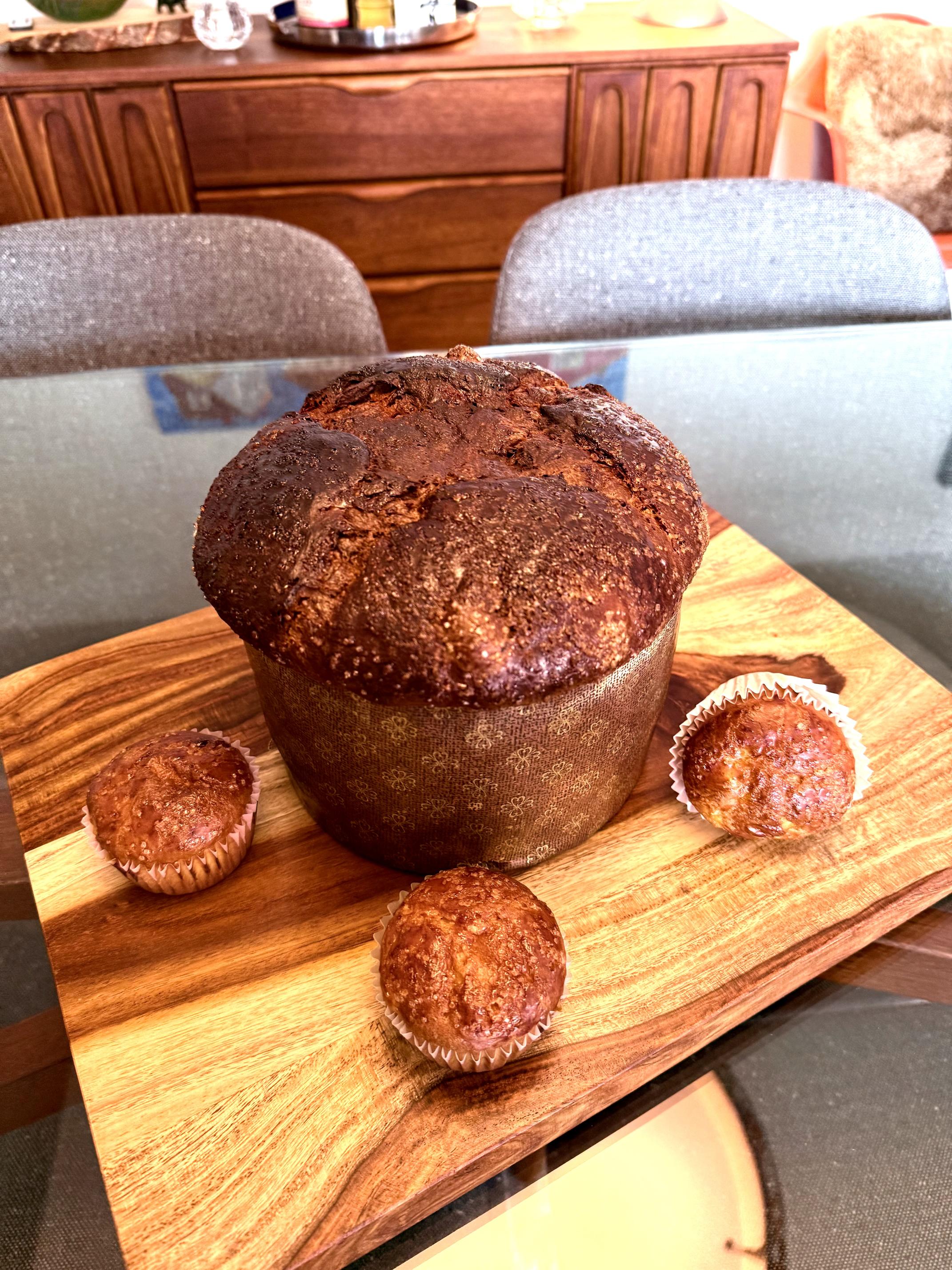
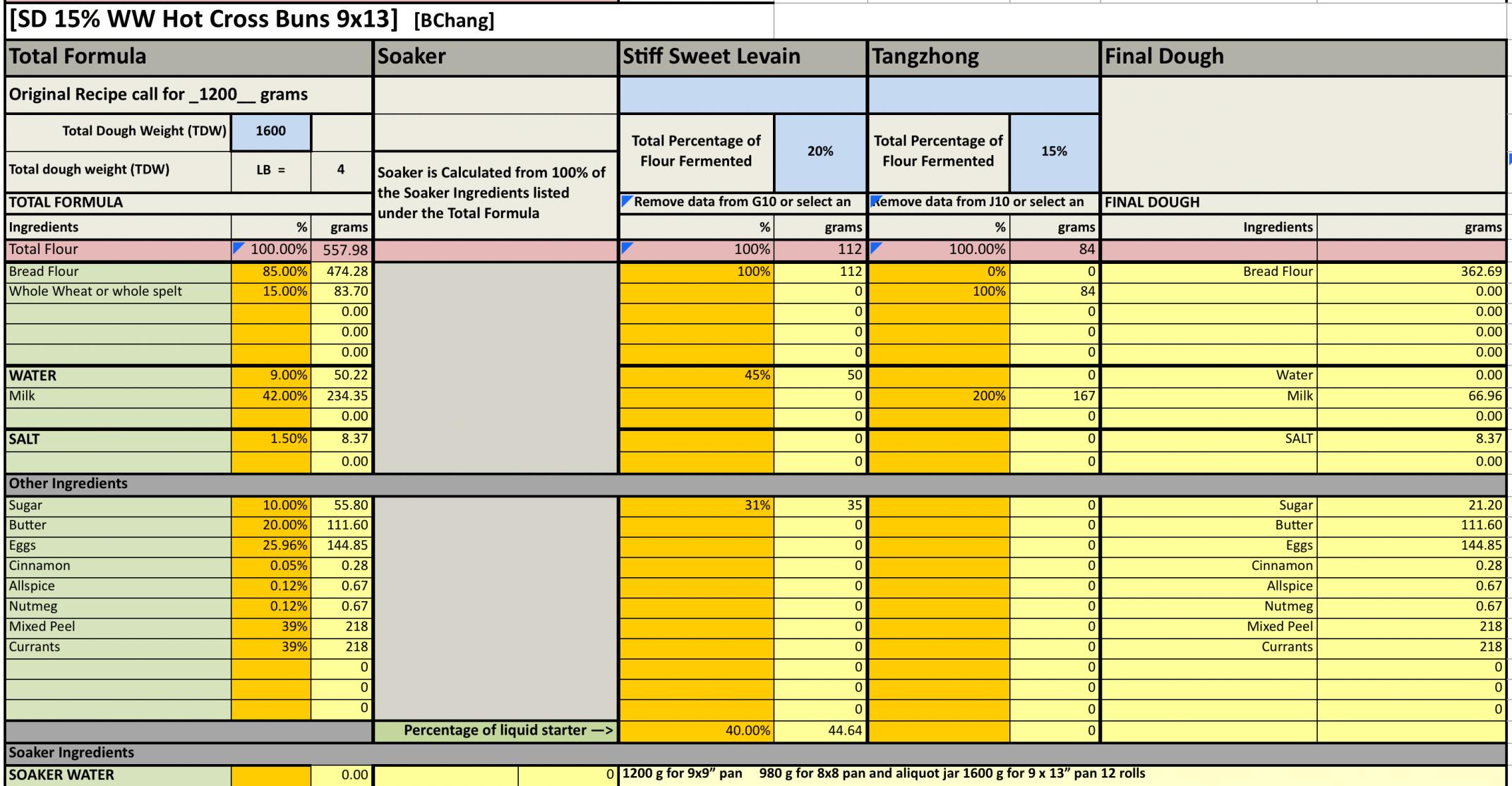
Makes 1 large loaf (950 g) + 250 g extra dough which I divided and placed into cupcake molds to make panettini.
Prep Time 4 days
Cook Time 50-55 minutes
Two day starter preparation
Aim to get starter active enough that it triples when fed 1:0.5:1 in 4 hours at 82ºF.
To deal with the overnight, create a stiff sweet starter by feeding the starter 1:0.5:1 and sugar 50% of total water and ferment at 78ºF. This will reduce the LAB population and slow the starter to last overnight and not be too acidic.
10 g starter, 5 g water, 3.75 g sugar and 10 g flour overnight (about 12 hours 77°F) and the follow with 3 feeds at 1:0.5:1. 12 g starter:6 g water:12 g flour twice then the final starter feed needs to have a final total weight of >30 g in order to make enough levain.
Final levain build 30 g starter, 15 g water and 30 g flour.
I believe we are targeting a pH of around 4.1 for the final levain.
Ingredients
First dough:
- Levain 75 g of 50% hydration
- 120 g water
- 240 g high gluten flour (~15% protein)
- 75 g sugar
- 75 g butter , softened not melted and cut into several pieces
- 55 g egg yolks (about 4)
Second dough:
- 60 g high gluten flour (15% protein)
- 2 g diastatic malt
- 70 g sugar
- 95 g egg yolks (about 5 or 6) divided to be added gradually
- 1/2 teaspoon salt (~3 grams) on 2nd day can add the salt to the aromatic mix
- All of the aromatic mix (recipe follows)
- 95 g butter, softened (not melted)and cut into several pieces, divided to be added ¾ and finally ¼
- 120 g rehydrated tart cherries, weigh after soaking
- 90 g candied lemon peel , diced small
Aromatic mix:
- 30 g honey
- 1 vanilla bean or 1 tsp of vanilla extract
One lemon grated
Egg wash (optional)
- One egg beaten with a splash of milk or cold water and pinch of salt
Instructions
***Day 1***. Overview and Preparation
- Overview of day 1: prepare aromatic mixture (will sit for 24 hours until day 2), soak tart cherries (soaks for 1.5 hours), refresh levain/starter 3 times throughout morning and afternoon (example, 8AM, noon, and 3PM), and then make first dough in evening (45 mins to 1 hour active time)
Mix Aromatic Blend and Soak tart cherries
- To begin, mix ingredients for aromatic blend in a small jar, cover and let sit for 24 hours
- Rehydrate cherries by soaking them in bowl of hot water for 30 minutes, rinse well and then soak again in warm water for 1 hours. Drain and then place on paper towel and let sit overnight. Make sure to re-weigh cherries once hydrated because you will need less as they will weigh more.
Refreshing your Starter/Levain (Liquid)
- Ensure that your levain has been refreshed enough times so that it is very active (suggestion is at least 3 feedings the day that you are making first dough) (eg, refresh at 8AM, noon, 3PM, and then use some to make first dough at 7PM). The 50% hydration starter fermented at 82°F should triple within 4 hours.
Mixing the First Dough (Primo Impasto) - evening of day 1. Refrigerate the mixing bowl and everything else other than the butter prior to mixing to help ensure a cool dough temperature during mixing below 78°F.
- When ready to mix the first dough, add the levain to the bowl of a stand mixer, along with flour and water. (For Ankarsrum Assistent start with dough hook, adding sugar at the start with the levain, water and flour before adding butter.)
- Mix for 10 to 15 minutes, then add sugar and then softened butter in several pieces. (For the Ankarsrum Assistent fold the butter into the dough in the bowl one at a time to speed butter incorporation. Switch to the paddle and roller at this point once the dough is softer)
- Only after butter is completely incorporated add the egg yolks in several stages.
- Ensure that the dough temperature stays under 26 degrees C (78F). If it goes higher, place dough in freezer for 10 minutes (remember this for second dough too)
- Mix for 25 minutes until you get a silky smooth elastic dough. The dough should achieve a great windowpane.
Bulk Rise of First Dough (12 hours/overnight)
- Place dough in large container (three times the size of the dough, I should use the 2nd largest bowl), cover, and let rise at 28/30 C (82 to 86F) for 12 hours. The target pH of the primo impasto is > 5.0 I believe.
- Once tripled in size, place in freezer for 30 mins to cool. This will help avoid overheating during the long mixing of secondo impasto
***Day 2***. Overview and Mixing of Second Dough (Secondo Impasto)
- Overview: Make dough two (45 mins), form loaves/rest dough (1 hour), let loaves rise (6 to 9 hours), and bake (35 mins to 1 hour, depending on liner size, see note)
- To begin, consider placing dough/bowl/hook/flour/fruit in refrigerator (everything except the butter) while measuring ingredients for dough two or even overnight.
- When ready to proceed, add flour and barley malt to the day 1 dough and mix at slow speed then medium for 15 minutes using the hook. (For the Ankarsrum Assistent start with first dough, flour, diastatic malt in the bowl and use the dough hook. Once most of the flour is incorporated gradually add the sugar. Once the dough starts to loosen switch to the paddle and roller before adding half the egg yolks)
- Slowly incorporate sugar
- Afterwards, add half the egg yolks, salt, and aromatic blend.
- Knead until smooth and homogenous
- Add 70 grams (about 3/4) of the softened butter, mix well, and then the rest of the yolks.
- Knead until smooth and so that the dough passes a great windowpane. Then add the remaining butter. Finally add the tart cherries, and the candied peel.
Bulk Rise of Second Dough
- Remove from machine onto buttered counter to weight and divide if needed. Let stand in buttered or oiled covered bowl for 30 minutes
- Remove dough from bow onto buttered counter. Form into tight boule. and let sit uncovered on counter for 15-30 minutes. Tighten the boule and then transfer to the form.
- https://youtu.be/NgVxXgaey_A?si=l7yIJbl2_k8_glx_ shaping video.
Final Rise of Second Dough
Optional, once the dough is in the form, pass the skewers through the form and dough to save time and reduce risk of the panettone collapsing once out of the oven. Place these just above the bottom of the form, placing them much higher can result in them tearing through the panettone a bit when it is hanging upside down.
- Allow loaves to rise in liners placed on a on baking sheet, covered by plastic wrap at a temp of 28 to 30 C (82 F to 86F) for 8.5 to 9 hours. You may leave the covered dough inside the oven (turned off!) with the oven light turned on for warmth if you have a cool kitchen. My dough took 7 hours to complete final proofing to start of baking.
- The dough should rise within 1 inch of top of mold at the edge where it meets the form. If it rises more than that, you risk getting a mushroom shaped panettone, which is not considered ideal. Preheat the oven and uncover the panettone at this point.
Preparing to Bake
- In the meantime, before baking, pre-heat the oven to 165 C (330 °F) and allow panettone to form skin by uncovering for 15 to 20 minutes prior to baking. Alternate start at 355°F.
- Brush the top with an egg wash and sprinkle the decorating sugar on top. Next cut a cross on top of panettone prior to baking and add a chunk of butter to the center
Bake loaves
Alternate baking start at 355°F for 12 mins then reduce to 330°F for 40 mins or so.
- Center should read 94 C (201 F) when done (takes about 50 to 55 minutes for 1 kg dough). For this bake I followed Sue’s baking starting at 355°F for 12 mins then 330°F for 45 mins. I wasn’t watching the panettone at the end and the top is more carmelized than I would have wanted. So I’ve reduced the bake time at 330°F to 40 mins.
- For panettini - bake at 355°F for 12 mins then 330°F for 15 mins. Cool on wire rack. These do not need to be inverted.
Invert and cooling of loaves
- To cool, immediately invert loaves by inserting wooden skewers across bottom and hang upside down on top of deep pot (see photo collage) (NOTE: you should use very pointy skewers or it may be difficult to pierce the panettone liners (I twist them for easy insertion; some folks pre-skewer their liners before baking. The loaves stick to the side of liners so they should not fall out. When serving, it is okay to cut right through paper and peel it off).
- After completely baked and cooled for 10-12 hours, place the loaves in plastic/cellophane bags. Before wrapping in plastic, you must wait 10 to 12 hours for loaves to completely cool. (to reduce risk of mold, consider spraying inside of bags with pure food grade alcohol and dry out completely before using)
- Panettone is best eaten at least 5 days after baking as the flavors continue to develop after baked.
I had a bit of trouble getting the skewers through the panettone mold and it did start to deflate a bit during that time. I didn’t skewer the panettone until after it was baked, perhaps next time I’ll do this prior to baking.
I’ll post crumb photos once I slide the panettone tomorrow.
- Benito's Blog
- Log in or register to post comments
I love those cup-nettone!
Do you have a template of decent entry level panettone formula? I nearly crack the code to work my bran-skim milk starter for enriched dough, and feel like trying
Jay
Yes I thought that the cupcake molds were a good use and way to bake a small panettones, which I’m calling panettini, since I had more dough than the panettone mold required.
Unfortunately I haven’t researched many panettone recipes. I’m not sure what an entry level formula would entail, sorry Jay.
Benny
I am impressed!!! I couldn’t even read the whole process lol! I’m glad there are bakers like you that can parse out such amazing details so successfully. 🙏
You’re too funny Caroline, but thank you. These still cause me some stress when planning the bake and while mixing. The Ankarsrum Assistent is a bit challenging and figuring out how best to use it for such a highly enriched dough that starts out very very low hydration. Now that I have done this formula twice, I think I have worked out how to use the Ankarsrum Assistent well. I’m not 100% sure that I’ve developed the gluten as much as it should be ideally.
Benny
Welcome back :) Love the little cupcakettini.
dw
Thank you Debra, I love the little panettinis. We were able to eat a couple of them almost right away!
Benny
... Waiting to see the crumb shot!
It sure looks like John Dough came through for you here. Assuming that is what you used as a base for your "quick LM".
Ummm.. is there a missing ingredient on that empty line for first dough?
-Jon
The panettone is in a bag hopefully developing its flavours.
John Dough II is definitely what I used to make the 50% hydration starter/levain LM. I’m hoping that doing things this way will allow me to avoid having to maintain a LM long term, instead of just making one over a couple of days ahead of making the primo impasto.
The gap in the ingredients for the primo impasto I put there to remind me of the ingredients that go into the dough at first and the others that go in later.
Benny
Can’t wait to see the crumb. Great detailed write up. I’m surprised you used the hook as I only use the roller for all my doughs.
Great idea with the new sweet starter versus maintaining a specialized one as usually required for this type of bake. I’m curious to know if it works just as well.
Best,
Ian
Thank you Ian, your comments are always appreciated.
I find when the dough is very low hydration as it is at the start of the primo and secondo impastos I have to use the hook. Otherwise anything even slightly higher hydration I use the paddle and roller.
I’m too lazy to maintain a LM long term so converting a portion of my 100% hydration starter to 50% with the intermediate step of the stiff sweet starter for the overnight works well enough at least. It probably isn’t perfect or ideal, but it works well enough if one isn’t a perfectionist.
Benny
Very nice, Benito! I hope you enjoyed the process!
I read through this recipe, will have a look at how it stacks up… most of the process is just the same as for the majority of recipes I’ve seen. However I’m wondering about the long final rise. Mine is about 4.5 hours.
Did you take a pH after the 1st impasto fermentation? I’m wondering how your sweet starter fared.
Regards, Sue
Thank you Sue, I am enjoying the process and getting used top using my Ankarsrum Assistent for making panettone. It is definitely a learning process each time though and I don’t have air down pat yet at all. But at least the panettone aren’t too shabby.
Interesting that your final proof is only 4.5 hours, perhaps I went a bit too long. I did lose a bit of height while I struggled with getting the skewers through the panettone mold. Getting them in was fine but getting the second out through the other side didn’t go quickly and I saw the top flatten a bit. Next time I’ll pass the skewers through ahead of time.
The pH of the Primo Impasto was 4.9 in the morning. I think that is a bit lower than last time. What do you usually see?
I wonder if my flour’s protein is a bit lower than ideal. I am estimating that mine is about 15%, but I don’t have an accurate measure of the bread flour that I start with so it could be lower than 15% after adding VWG. The last panettone wasn’t as shreddable as I was expecting so I wondered about the flour being too low in protein vs not developing it enough.
Benny
That is a perfectly fine pH, mine range between 4.6 and 5.1. The higher pH is usually associated with a little better crumb and rise, but this is not absolute. 4.9 ensures that your gluten was in decent shape at that point.
I’ve never added gluten to my flour, but I know that in theory it should work. I use panettone flour that is about 15%,, so yours should be ok.
Shreddability is IMO, all other things being equal, related to mixing and handling techniques. You have to really “go for it” at the first step in impasto 1, much more than anyone would be comfortable doing with bread dough. And then in the first step of the second impasto, when you mix impasto 1 with flour. That needs to be very well developed and can take “a while”.
Also, preshaping and pirlatura are important to get the structure you’re looking for in the final result.
Anyway, great result and you should be really happy with these!
—Sue
I’ll need to work the mix at the beginning of the Primo and secondo impastos longer I guess. Thank you for your feedback Sue, it is much appreciated.
Benny
Not too shabby, but not quite right yet. For my oven, starting at 355°F for the first 12 mins and then dropping to 330°F is probably just too hot. The crumb is just a touch dryer than I’d prefer and the crust is too dark. I’ll go back to 330°F for baking next time.
The crumb could be more open, I wonder if my flour is high enough in protein. I also wonder since I am not using a panettone flour if there are other characteristics of the flour that would give me a better result. Finally, I’ll have to work on the shaping a bit.
Overall I’m pleased with this bake and each one is a good learning experience. It might be some time before I’ll bake another panettone but next time I’ll go back to making candied orange peel and making the aromatic mix a combination of both orange and lemon as I preferred those flavours to just lemon alone.
I know you really strive for perfection, but these do look extremely good to me. And even if the crumb is not as open as you would have liked it to be, I'm sure the taste was excellent. I look forward to more of your panetonne bakes in future.
Thank you Lin, you know me too well. But yes the flavour is great, but I think I prefer candied orange more than just candied lemon.
Benny
But I bet you make it. Mwilson posted an old black and white video of Pannetone factory in Italy a long while ago. The part I found interesting was the proof was mostly done free standing and then a machine wrapped the paper around the dough and cinched it up enough to force the dough inward and upward then it was stapled or glued to help achieve that vertically elongated crump that looks so appealing. I don’t know if that could be easily replicated but it was instructive.
Thank you for your comments Don. That goes to what Sue mentioned that the shaping will affect the crumb. I am probably not tightening the dough enough during shaping. Perhaps I need to get the dough a bit more cylindrical rather than just spherical. Oh well, not perfect, but not a disaster either so overall I’m happy with it.
Benny
Making panettone is always a journey full of surprises and learning opportunities. With each panettone I bake I agree more and more with this post on worldloaf.org
https://newsletter.wordloaf.org/eight-lessons-from-my-panettone-saga/
I like the idea of using the cupcake molds for excess dough. It's now on my list ;)
I don't have any experience with the Ankarsrum, but from what I've heard, the mixing process takes always longer than with a Kenwood Chef when it comes to regular bread dough. I can imagine that mixing panettone with Ankarsrum can be pretty challenging.
Making panettone is definitely an up and down journey. Luckily I haven’t had disasters yet and hopefully I won’t ever. I’ll have a look at that website and hopefully pick up some useful tips.
Regarding the Ankarsrum Assistent I actually don’t find that it takes longer to knead bread dough at least compared to my old Kitchenaid mixer. However, some of that might be my lack of experience using it to mix very low hydration doughs such as the beginning of the mix for the Primo Impasto and the beginning of mix of the Secondo Impasto. Hopefully with more time, I figure out the most efficient way to use the Ankarsrum Assistent with the hook for very low hydration doughs.
Benny